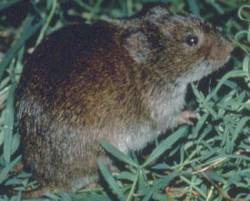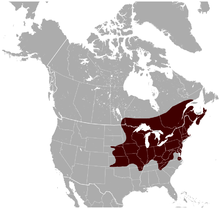
The muskrat is a medium-sized semiaquatic rodent native to North America and an introduced species in parts of Europe, Asia, and South America. The muskrat is found in wetlands over a wide range of climates and habitats. It has important effects on the ecology of wetlands, and is a resource of food and fur for humans.

The eastern meadow vole, sometimes called the field mouse or meadow mouse, is a North American vole found in eastern Canada and the United States. Its range extends farther south along the Atlantic coast.

The sagebrush vole is a tiny vole found in western North America. It is the only member of the genus Lemmiscus.

The North American water vole or just water vole is the largest North American vole. It is found in the northwestern United States and southern parts of western Canada. This animal has been historically considered a member of genus Arvicola, but molecular evidence demonstrates that it is more closely related to North American Microtus species. Water voles are on the USDA Forest Service Region 2 sensitive species list because they maintain very small populations and there is high concern that their required habitat may be declining.

The northern bog lemming is a small North American lemming. It is one of two species in the genus Synaptomys, the other being the southern bog lemming. It is sometimes placed in its own genus, Mictomys.

Synaptomys is a genus of North American lemmings. These animals live in wet forested and open areas. They are small, cylindrical rodents with large heads and short ears, legs, and tails. They eat green vegetation such as grasses and sedges. They are often found in colonies.

The Ungava collared lemming or Labrador collared lemming is a small North American lemming.

Lemmini is a tribe of lemmings in the subfamily Arvicolinae. Species in this tribe are:

The western heather vole is a small vole found in western North America. Until recently, the eastern heather vole,, was considered to be a subspecies. They have short ears with stiff orange hair inside and a short thin tail which is paler underneath. Their long soft fur is brownish with silver grey underparts. They are roughly 14 cm (5.5 in) long with a tail length shorter than one-half their body length, approximately 50 mm (2.0 in). They weigh about 40 g (1.4 oz).

The eastern heather vole,, is a small North American vole. Until recently, this species was considered to belong to the same species as the western heather vole, Phenacomys intermedius. It is also called the Ungava vole.

The short-tailed field vole, short-tailed vole, or simply field vole is a grey-brown vole, around 10 cm in length, with a short tail. It is one of the most common mammals in Europe, with a range extending from the Atlantic coast to Lake Baikal. These voles are found in moist grassy habitats, such as woodland, marsh or on river banks. Although they make shallow burrows, they usually build nests above ground. They are an important food source for owls and some other predators and their population size tends to peak and trough cyclically. Field voles breed prolifically, mainly in summer, but often all year round, even under snow. Females produce up to seven litters a year, each averaging from four to six young which are weaned after about fourteen days. The short-tailed field vole is both widespread and common and is listed as being of "Least Concern" by the IUCN.

The California vole is a type of vole which lives throughout much of California and part of southwestern Oregon. It is also known as the "California meadow mouse", a misnomer as this species is a vole, not a mouse. It averages 172 mm (6.8 in) in length although this length varies greatly between subspecies.

The silver mountain vole is a species of rodent in the family Cricetidae. They are distinguished by their silver-grey pelage, long vibrissae, rootless hypsodont molars and angular skull shape. Like many mammals of the Eurasian Steppe eco-region, they are well adapted to life in high altitudes, and can be found in mountain areas of Central Asia from Saur Mountains in the north-east to Kugitang Range in the west, and to Tibet and the Himalayas in the south.

The montane vole is a species of vole native to the western United States and Canada.

Thirty-seven species of mammals have been identified at Indiana Dunes National Park. Four other species are thought to inhabit the park, but have not been documented: the northern long-eared myotis, the Indiana bat, the hoary bat, and the southern bog lemming

A lemming is a small rodent, usually found in or near the Arctic in tundra biomes. Lemmings form the subfamily Arvicolinae together with voles and muskrats, which form part of the superfamily Muroidea, which also includes rats, mice, hamsters, and gerbils. In popular culture, a longstanding myth holds that they exhibit herd mentality and jump off cliffs, committing mass suicide.
Listrophorus is a genus of parasitic mites in the family Listrophoridae. North American species with their hosts include:

The western meadow vole is a species of North American vole found in midwestern and western Canada and the United States, and formerly in Mexico. It was formerly considered conspecific with the eastern meadow vole, but genetic studies indicate that it is a distinct species.



















